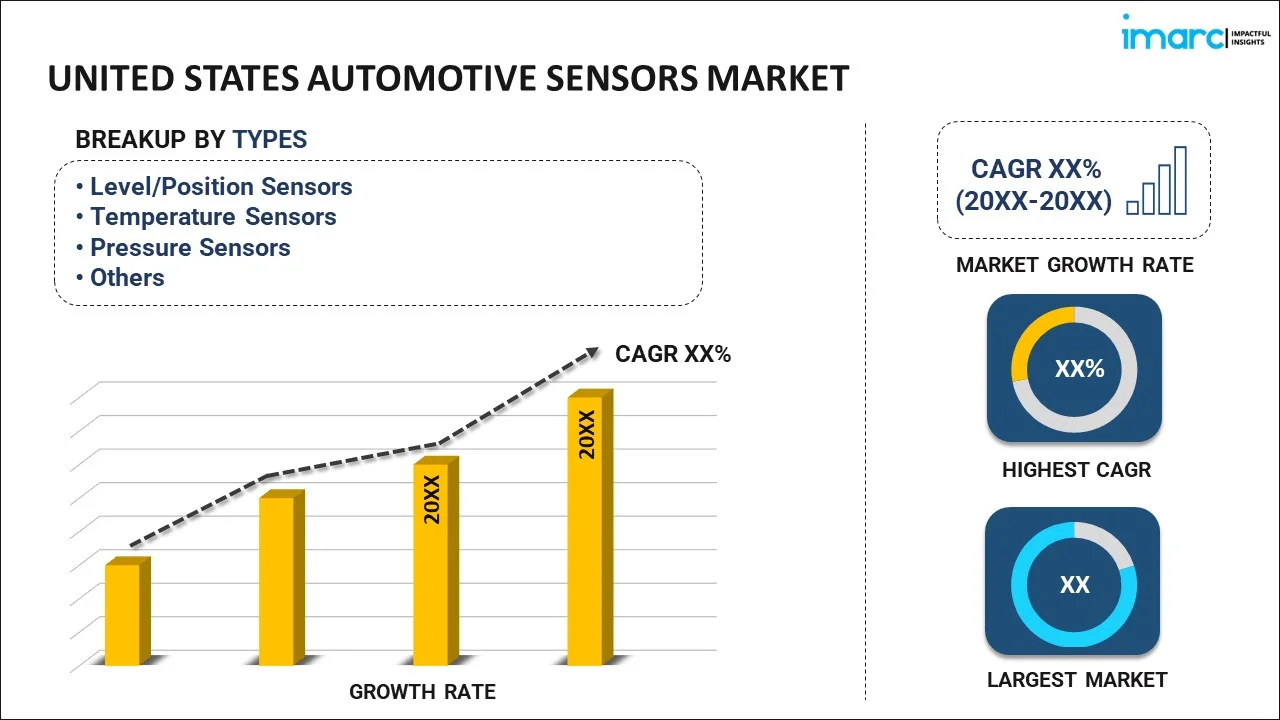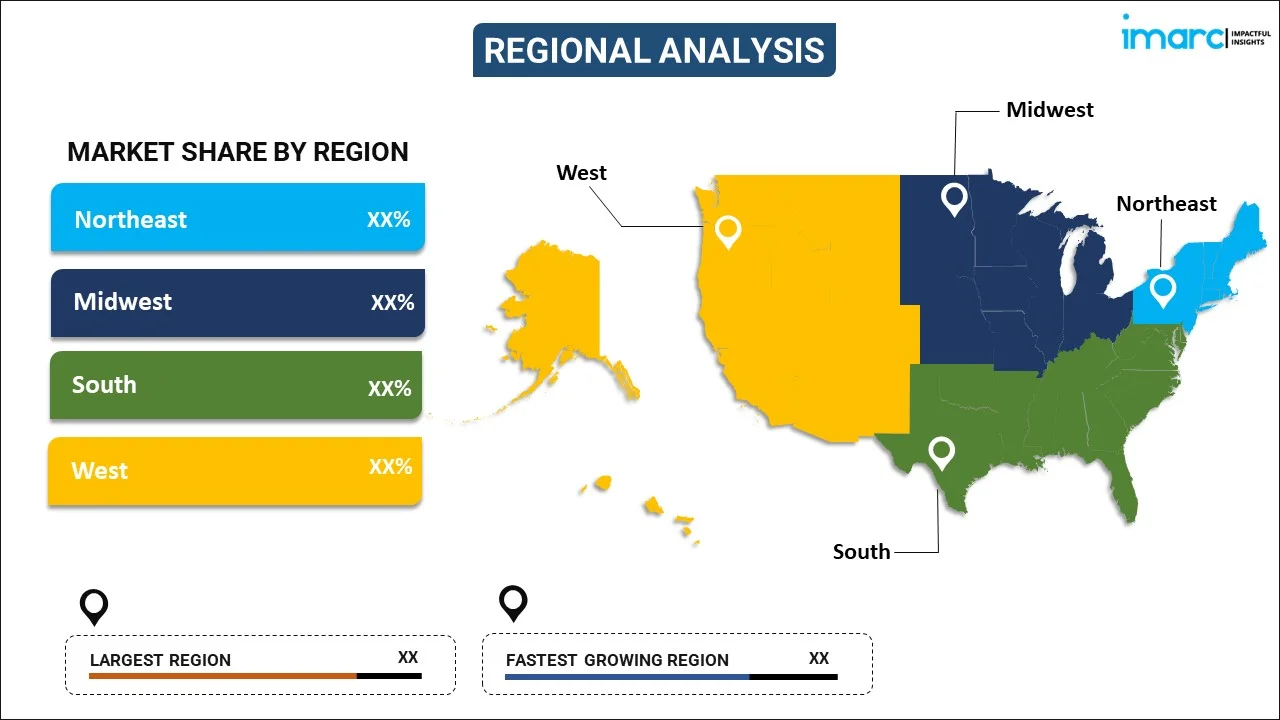
United States Automotive Sensors Market Report by Type (Level/Position Sensors, Temperature Sensors, Pressure Sensors, Speed Sensors, Gas Sensors, Magnetic Sensors, and Others), Vehicle Type (Passenger Cars, Commercial Vehicles), Application (Powertrain, Chassis, Vehicle Body Electronics, Safety and Security, Telematics, and Others), Sales Channel (Original Equipment Manufacturer (OEM), Aftermarket), and Region 2025-2033
Market Overview:
United States automotive sensors market size reached USD 5.5 Billion in 2024. Looking forward, IMARC Group expects the market to reach USD 11.1 Billion by 2033, exhibiting a growth rate (CAGR) of 7.6% during 2025-2033. The increasing demand for sensors that facilitate communication between different vehicle systems and enable features like telematics, vehicle-to-vehicle (V2V) communication, and vehicle-to-infrastructure (V2I) communication, is driving the market.
|
Report Attribute
|
Key Statistics
|
|---|---|
|
Base Year
|
2024
|
|
Forecast Years
|
2025-2033
|
|
Historical Years
|
2019-2024
|
|
Market Size in 2024
|
USD 5.5 Billion |
|
Market Forecast in 2033
|
USD 11.1 Billion |
| Market Growth Rate 2025-2033 | 7.6% |
Automotive sensors are vital components in modern vehicles, playing a crucial role in monitoring and controlling various systems to enhance performance, safety, and efficiency. These sensors detect and measure parameters such as temperature, pressure, speed, proximity, and more, translating real-world conditions into electronic signals. Common examples include ABS sensors for anti-lock braking systems, airbag sensors for occupant safety, and temperature sensors for engine management. Advanced sensors like LiDAR and radar are pivotal in enabling autonomous driving capabilities. The data collected by these sensors is processed by onboard control units, allowing the vehicle to make informed decisions and adjustments. Overall, automotive sensors are integral to the functionality and intelligence of vehicles, contributing significantly to the evolution of smart and connected automobiles.
United States Automotive Sensors Market Trends:
The automotive sensors market in the United States is experiencing robust growth, primarily driven by advancements in technology and increasing consumer demand for enhanced safety and efficiency in vehicles. One of the key drivers is the escalating focus on vehicle electrification as governments push for eco-friendly solutions to combat environmental challenges. Moreover, the rising trend of autonomous vehicles has propelled the demand for a sophisticated sensor ecosystem, enabling these vehicles to navigate and interact with their surroundings seamlessly. Furthermore, the growing awareness of safety features among consumers has led to an upsurge in the adoption of advanced driver-assistance systems (ADAS), which heavily rely on sensors for functions like collision avoidance and lane departure warnings. Additionally, the surge in the production of electric and hybrid vehicles has augmented the need for sensors to monitor battery health, temperature, and overall performance. The integration of Internet of Things (IoT) technologies in automotive systems further amplifies the demand for sensors, creating a connected ecosystem where vehicles can communicate with each other and with infrastructure. In conclusion, the automotive sensors market in the United States is being propelled by a confluence of factors, including the drive toward electric vehicles, the push for autonomous driving technologies, heightened safety consciousness, and the integration of IoT, collectively shaping the future of the automotive industry.
United States Automotive Sensors Market Segmentation:
IMARC Group provides an analysis of the key trends in each segment of the market, along with forecasts at the country level for 2025-2033. Our report has categorized the market based on type, vehicle type, application, and sales channel.
Type Insights:

- Level/Position Sensors
- Temperature Sensors
- Pressure Sensors
- Speed Sensors
- Gas Sensors
- Magnetic Sensors
- Others
The report has provided a detailed breakup and analysis of the market based on the type. This includes level/position sensors, temperature sensors, pressure sensors, speed sensors, gas sensors, magnetic sensors, and others.
Vehicle Type Insights:
- Passenger Cars
- Commercial Vehicles
A detailed breakup and analysis of the market based on the vehicle type have also been provided in the report. This includes passenger cars and commercial vehicles.
Application Insights:
- Powertrain
- Chassis
- Vehicle Body Electronics
- Safety and Security
- Telematics
- Others
The report has provided a detailed breakup and analysis of the market based on the application. This includes powertrain, chassis, vehicle body electronics, safety and security, telematics, and others.
Sales Channel Insights:
- Original Equipment Manufacturer (OEM)
- Aftermarket
A detailed breakup and analysis of the market based on the sales channel have also been provided in the report. This includes original equipment manufacturer (OEM) and aftermarket.
Regional Insights:

- Northeast
- Midwest
- South
- West
The report has also provided a comprehensive analysis of all the major regional markets, which include Northeast, Midwest, South, and West.
Competitive Landscape:
The market research report has also provided a comprehensive analysis of the competitive landscape in the market. Competitive analysis such as market structure, key player positioning, top winning strategies, competitive dashboard, and company evaluation quadrant has been covered in the report. Also, detailed profiles of all major companies have been provided.
United States Automotive Sensors Market Report Coverage:
| Report Features | Details |
|---|---|
| Base Year of the Analysis | 2024 |
| Historical Period | 2019-2024 |
| Forecast Period | 2025-2033 |
| Units | Billion USD |
| Scope of the Report | Exploration of Historical Trends and Market Outlook, Industry Catalysts and Challenges, Segment-Wise Historical and Future Market Assessment:
|
| Types Covered | Level/Position Sensors, Temperature Sensors, Pressure Sensors, Speed Sensors, Gas Sensors, Magnetic Sensors, Others |
| Vehicle Types Covered | Passenger Cars, Commercial Vehicles |
| Applications Covered | Powertrain, Chassis, Vehicle Body Electronics, Safety and Security, Telematics, Others |
| Sales Channels Covered | Original Equipment Manufacturer (OEM), Aftermarket |
| Regions Covered | Northeast, Midwest, South, West |
| Customization Scope | 10% Free Customization |
| Post-Sale Analyst Support | 10-12 Weeks |
| Delivery Format | PDF and Excel through Email (We can also provide the editable version of the report in PPT/Word format on special request) |
Key Questions Answered in This Report:
- How has the United States automotive sensors market performed so far and how will it perform in the coming years?
- What has been the impact of COVID-19 on the United States automotive sensors market?
- What is the breakup of the United States automotive sensors market on the basis of type?
- What is the breakup of the United States automotive sensors market on the basis of vehicle type?
- What is the breakup of the United States automotive sensors market on the basis of application?
- What is the breakup of the United States automotive sensors market on the basis of sales channel?
- What are the various stages in the value chain of the United States automotive sensors market?
- What are the key driving factors and challenges in the United States automotive sensors?
- What is the structure of the United States automotive sensors market and who are the key players?
- What is the degree of competition in the United States automotive sensors market?
Key Benefits for Stakeholders:
- IMARC’s industry report offers a comprehensive quantitative analysis of various market segments, historical and current market trends, market forecasts, and dynamics of the United States automotive sensors market from 2019-2033.
- The research report provides the latest information on the market drivers, challenges, and opportunities in the United States automotive sensors market.
- Porter's five forces analysis assist stakeholders in assessing the impact of new entrants, competitive rivalry, supplier power, buyer power, and the threat of substitution. It helps stakeholders to analyze the level of competition within the United States automotive sensors industry and its attractiveness.
- Competitive landscape allows stakeholders to understand their competitive environment and provides an insight into the current positions of key players in the market.
Need more help?
- Speak to our experienced analysts for insights on the current market scenarios.
- Include additional segments and countries to customize the report as per your requirement.
- Gain an unparalleled competitive advantage in your domain by understanding how to utilize the report and positively impacting your operations and revenue.
- For further assistance, please connect with our analysts.
 Inquire Before Buying
Inquire Before Buying
 Speak to an Analyst
Speak to an Analyst
 Request Brochure
Request Brochure
 Request Customization
Request Customization




.webp)




.webp)












